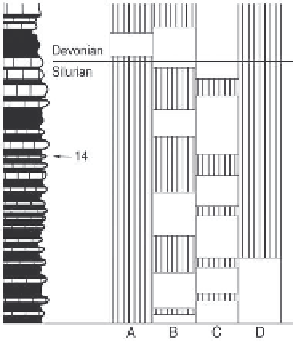Geology Reference
In-Depth Information
Plate 114 Standard Microfacies Types: SMF 4 and SMF 5
SMF 4. Microbreccia, bioclastic-lithoclastic packstone or rudstone
Criteria:
Fine-grained breccias, debrites and turbidites consisting of grains of various origin. Grains are com-
monly worn and rounded and may consist of both locally derived bioclasts, imported shallow-water material and
previously cemented lithoclasts. Grains may be either polymict in origin or of uniform composition. Grading
textures are common. Grains can be mixed with quartz, cherts and extraclasts. This rock type includes both fine
talus and also debris laid down by turbidites (e.g. in 'allodapic limestones', Meischner 1965).
Occurrence:
Foreslope talus, resedimented limestones. Basinal settings (FZ 1) and toe-of-slope settings (FZ 3).
SMF 5. Allochthonous bioclastic grainstone, rudstone, packstone and floatstone or breccia
Criteria:
Densely packed whole fossils and fossil fragments with a high percentage of reef-derived organisms.
The bioclasts occur in a chaotic order or they form depositional structures with characteristic patterns (e.g.
turbidite sequences).
Occurrence:
Reef-flank facies, slope (FZ 4), adjacent to reefs. Deposited in forereef posi-
tion and reef slopes, or in backreef settings and in lagoons. Inner ramps.
Additional picture:
Pl. 58/1.
1
SMF 4.
Polymict clast-supported microbreccia,
consisting of carbonate litho- and bioclasts and quartz grains (most white
particles). Carbonate grains are subangular to subrounded (fields G, I and L of the Krumbein chart; see Fig. 4.30). Most
quartz grains correspond to the fields P and Q (low sphericity and low roundness). Carbonate grains are lithoclasts (L) and
bioclasts including bivalves (B), bryozoans (BR), echinoderms (E), foraminifera (F), finely agglutinated orbitolinid fora-
minifera (OF), and rudist bivalves (R). Debris flow. Toe-of-slope (FZ 3). Late Cretaceous: Northern Calcareous Alps.
2
SMF 4, SMF 2 and SMF 1.
Allochthonous and autochthonous deep-water sedimentation.
The coarse-grained lower part
of the basal unit yields thin brachiopod shells (B) deposited in 'convex-up' positions. The center part (packstone, PS)
consists of micrite clasts and thin, parallel arranged shells. The overlying layer is a fine-grained grainstone (GS) depos-
ited within a relief (arrows) of the underlying packstone. Packstone and grainstone display indistinct lamination caused
by parallel arranged thin shells. Note the differences in grain sizes and the sharp boundary between the fine-grained
grainstone and the overlying brachiopod-bearing lime mudstone (M). Shell orientation patterns indicate the existence of
weak currents. The sample exhibits three SMF Types: The basal layer with brachiopod shells represents SMF 4. The
packstone and grainstone layers correspond to SMF 2. The uppermost part reflects the basinal background sedimentation
(lime mudstone with scattered fossils, SMF 1). Sedimentation took place in a deep shelf environment (FZ 3), see Fig.
14.16. Uppermost Silurian (Lochkovian): Klonk near Suchomasty, southwest of Prague, Czech Republic.
3
SMF 5.
Phylloid algal floatstone.
Characteristic criteria of SMF 5 are the abundance of reef-derived fossils, the chaotic
fabric and the packstone texture of the matrix. Most bioclasts of the sample shown here are fragmented plates of udotea-
cean green algae (see Sect. 10.2.1.5). Some fragments are coated and encrusted by foraminifera. The plates are jumbled
together and form a self-supporting framework that was infilled by the matrix. Shells (S) of gastropods and bivalves and
fusulinid foraminifera (F) are of minor importance. The matrix is an organic-rich packstone consisting of silt-sized pe-
loids and some quartz grains. The sample comes from flank beds of a shelf-margin mound that was subaerially exposed
several times. The mound material was redeposited near the mound core. The algal plates are strongly leached and partly
filled with gray micritic sediment (black arrow). The original algal structures are completely destroyed. Many phylloid
algal buildups of the southwestern U.S.A. are excellent reservoir rocks. Porosity developed through early vadose leaching
of skeletal grains and dissolution of parts of the matrix, combined with fracturing and brecciation. Late Pennsylvanian
(Holder Formation): Yucca Mound, northern Sacramento Mountains, New Mexico, U.S.A.
-> 2: Hladil 1992
Fig. 14.16.
Microfacies assists in differentiating allochthonous and background
sedimentation in deep-marine environments.
The sample on Pl. 114/2 comes from
the international stratotype of the Silurian-Devonian boundary. Questions concerning
a possible turbiditic origin of the boundary bed have been clarified by a microfacies
study (Hladil 1992). Common microfacies types are hemipelagic laminites, current-
derived laminites and lime shale and muddy limestones with graptolites. Coarse
calciturbidites are rare. The microfacies of bed 14 exhibits criteria of current-
controlled deposition (packstones and grainstones; SMF 2), deposition of
argillaceous and calcareous material (mudstone, SMF 1), and only minor
allochthonous sedimentation (brachiopod accumulation at the base of the bed, SMF
4). Most of the other limestone beds of the Klonk section exhibit similar microfacies
composition. Modified from Hladil (1992).
A: Laminite; B: Current-generated limestone; C: Coarse turbidite; D: Lime shale
and muddy limestones with graptolites.

